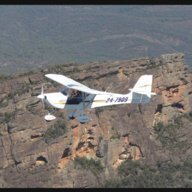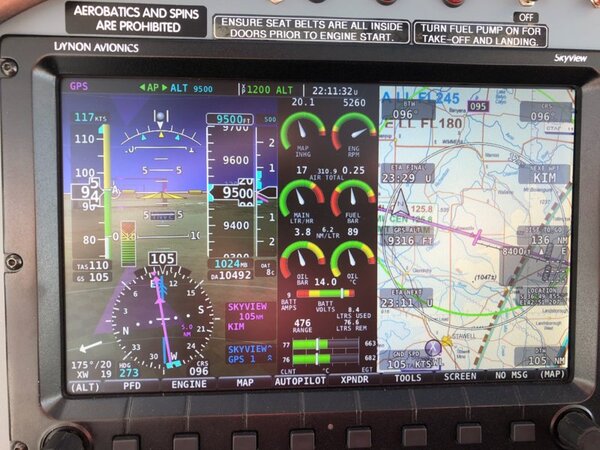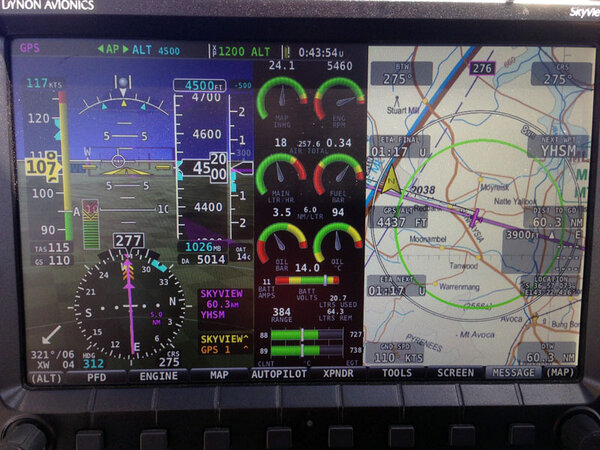-
Posts
493 -
Joined
-
Last visited
-
Days Won
4
Content Type
Profiles
Forums
Gallery
Downloads
Blogs
Events
Store
Aircraft
Resources
Tutorials
Articles
Classifieds
Movies
Books
Community Map
Quizzes
Videos Directory
Everything posted by dsam
-

Par Avion BN-2 Accident South West Tasmania
dsam replied to Rotorwork's topic in Aircraft Incidents and Accidents
Excluding severe mountain wave factors, CFIT is a sad & puzzling outcome to me. These days, for the price of an iPad & EFB software, every aircraft & pilot in Australia has excellent terrain & weather awareness at their fingertips. With this modern equipment, and competent planning & airmanship, CFIT in mountainous areas should be a thing of the past. I can only imagine that other factors must be involved (eg. loss of engine thrust, or unseen airframe icing...). -

Par Avion BN-2 Accident South West Tasmania
dsam replied to Rotorwork's topic in Aircraft Incidents and Accidents
I did an enjoyable day visit as a passenger with Par Avion down to Melaleuka a couple years ago, travelling on a fine day. As a frequent Tassie visitor, I know very well how the weather down that way can become suddenly challenging. Condolences to the family, friends, and colleagues of the pilot - very sad. -
I'm forever grateful that my (early 1970's) original flying experience was in a glider where spins, spiral dives, and sideslipping were a major part of my basic training, (along with rope & winch-break straight ahead forced landings that were somewhat common). All my glider final-approaches were set up somewhat too high, so sideslips on final were normal, then levelling the wings near flare, along with use of spoilers near touch-down. These days, I'm happy that my Eurofox (with its full-length hanging flaperons) makes an excellent platform for well-controlled sideslipped short landings. It is particularly helpful at unfamiliar aerodromes where there may be unseen wires, fences etc. on short final. My natural approach instinct has a steeper angle of decent on short final, so sideslips are second nature to me, and the steep angle keeps me well away from any unknown/unseen obstacles on my approach to the threshold. Yes, sideslips are always a natural option for me.
-

Lufthansa A350 Munich to Tokyo: comprehensive flight coverage
dsam posted a topic in Aviation Videos
If you ever wanted to know how a Lufthansa A350 crew enjoys their career, here is an edited multi-cam view of a flight from Munich to Tokyo. Yes, it's a longish video, but they've covered everything you might ever want to know (and perhaps a bit more...) You get an insight to the electronic capabilities of the aircraft, as well as the career path taken by the crew (front and back). More than the usual amount of hand-flying, I believe. Very informative for me...: -
What an absolute cock-up! Who do we blame for this? CASA? Airservices? Who do we sue when there is a midair because of this bureaucratic cluster f#*k? Disgraceful!
-
Ok here is another data point: YLIL to YCBA, 4.2 hours wheels-off to landing, 70.52 litres at the pump to re-fill (16.79 litres per hour). It is rather consistent with the real time readout on the Dynon Skyview.
-
I get a wealth of data from the Dynon Skyview, but to be fair, the spreadsheet is merely a collection of (constantly updating) data points (from photos like the attached) over 2 flights on different days across a range of altitudes, temperatures, QNH etc etc. Lots of variables involved, but good enough for some fairly good predictability when flight planning future trips. The Auxiliary pump was mistakenly left on for the early part of that flight test (it is capable of being left on long-term). I tend to only turn it off after I’ve climbed past 2000 AGL to give me time to rectify any (unlikely) negative fuel-surge surprises necessitating re-starting. That’s never happened yet, but I usually notice a momentary fuel pressure drop in the gauge when I switch it off each time. Distance per litre is a quick visual reference for me, along with the Range readout (vs Distance to Go readout), and wind vector display. It helps me find the optimum altitude under actual MET conditions, all during climb out, and throughout a cross country trip. From this recent photo, I read a data point of 110 KTAS @ 17 lph, 5260 RPM, MAP 20.1, 9500 ft (DA 10492 ft) OAT 8 degrees, QNH 1024 I calibrated the k-factor for the Dynon fuel-flow by my record-keeping of actual fuel to fill at the pumps along my trips.
-
For anyone that is interested, here is a spreadsheet for my Eurofox 3K with a Rotax 912ULS and a 3 blade FITI ground adjustable propeller. It details my actual fuel flow data points at various altitudes, speeds (IAS & TAS) manifold pressure, and RPM. I've got my reported fuel flow calibration k-factor within 3% of actual refuelling quantities over a number of cross country trips. In nil wind conditions, I usually get 6 nautical miles per litre of premium unleaded petrol at 110 knots TAS at 5500 - 6500 feet. I tend to flight-plan conservatively for 105 knots TAS @ 19 litres per hour, and a 10% variable reserve on top of my fixed reserve. Eurofox fuel & speed performance vs Altitude.xls Eurofox fuel & speed performance vs Altitude.xls Eurofox fuel & speed performance vs Altitude.xls
-

Two dead in gyrocopter crash near Orange 31/10/18
dsam replied to red750's topic in Aircraft Incidents and Accidents
-

How long until RAA get a weight increase approved?
dsam replied to NT5224's topic in Governing Bodies
Bruce, I remember that Janus wing test-rig very well. I was in a technical media unit at RMIT filming that test-rig over many weeks. Your account matches my recollections too. We did a video called “Beyond 3000 Hours” as I recall... (probably still available at the RMIT library). We included some air to air footage (at Benalla) of another Janus doing loops to show natural flex, compared to the hydraulic test-rig. The airborne flex was similar, but less extreme compared to the test-rig load program. -

Alternative to steam gauges... opinions sought
dsam replied to Marty_d's topic in Aircraft General Discussion
Yes, in fact I have. On a VFR navex to Broken Hill, entering circuit, an early version of Dynon firmware became frozen (this one and only time, thankfully) No PFD! I continued circuit & landing using secondary panel GPS moving map for groundspeed. Also had 2 iPads and iPhone for similar data. I remained confident I could complete the circuit for an uneventful arrival and re-boot of the Dynon. Notably, electrical failure wasn’t really the issue, - firmware was. The backup battery in the Dynon would have supplied 1 hour of frozen screen! The real lesson from this is redundancy of instrumentation, not electrical failure/backup power. Of course, having a good basic technique of VFR flying by attitude & power settings also comes into play - not ideal, but quite feasible when necessary. I love sophisticated instrumentation, but old fashioned airmanship is the primary fallback safety factor IMHO. Airmanship that dictates bringing redundant equipment where feasible. -

Alternative to steam gauges... opinions sought
dsam replied to Marty_d's topic in Aircraft General Discussion
My 2 cents worth... if your only signal connection with the flight sensor pod is wifi or Bluetooth to your display, that concerns me (wired is better IMHO). Also, in Australia’s hot sunny summer, iPads can “thermal shut-down”, and not show any display until cooled off. Again, not so ideal. Full disclosure: I am extremely satisfied with my Dynon Skyview. My iPads are for flight planning, OzRunways + AvPlan traffic info, maps etc. My only “steam gauge” is a magnetic compass. -
I sometimes wonder whether this smaller type of flat spin recovery parachute should be re-discovered for spin training/testing. https://ntrs.nasa.gov/archive/nasa/casi.ntrs.nasa.gov/19800011745.pdf Deployment doesn’t result in write-off the aircraft, nor occupant injury because the aircraft remains landable afterwards.
-

Airventure Australia 2018 Cessnock - Success or Not?
dsam replied to Roundsounds's topic in AUS/NZ General Discussion
It was suggested that one reason for the fewer number of under-wing tents was the ageing pilot population being less willing to sleep that way. Cessnock was, in part, chosen for that reason, since more and better accommodation was on offer in the hunter valley. The crappy wet weather on Thursday may well have put off a number of fly-in visitors too -

Rasberry Pi ADS-B receiver experiences?
dsam replied to Bleve97's topic in Instruments, Radios and Electronics
Out of technical curiosity, is the glider traffic data coming from their FLARM signals? If so what airborne data comes through, and over what range? -

Rasberry Pi ADS-B receiver experiences?
dsam replied to Bleve97's topic in Instruments, Radios and Electronics
Quite right Bevan. How sad that the other Aussie EFB supplier doesn’t seem to respect the safety advantages that that would bring, despite your generous efforts. -

Rasberry Pi ADS-B receiver experiences?
dsam replied to Bleve97's topic in Instruments, Radios and Electronics
Super Cub, as an early adopter & tinkerer, my Raspberry Pi is just a rudimentary 1090 MHz receiver for transponders in my vicinity. I am aware of the more refined Dynon DRX fully suited to the USA environment (Dual Band Traffic via 978 MHz (UAT) and 1090 MHz) having additional functionality provided by the system in their country. I believe the DRX is now compatible with the latest versions of AvPlan and OzRunways - but only displays the functionality provided by our Australian system. I know that the Dynon rep from USA will be at AirVenture Australia in Cessnock this week so I can ask some more detailed questions regarding this when I am there. -

Rasberry Pi ADS-B receiver experiences?
dsam replied to Bleve97's topic in Instruments, Radios and Electronics
For obsessive techie sorts like myself, I also run a version of OzRunways in (addition to my regular AvPlan) That allows me to see “paints” from OzRunways users, many of whom have no transponder, nor lodged flightplan. As recreational pilots that’s understandable, but it just gives me that added bit of situational awareness along with my Raspberry Pi. -

Rasberry Pi ADS-B receiver experiences?
dsam replied to Bleve97's topic in Instruments, Radios and Electronics
I’ve just had the good fortune to attend a demonstration by Bevan of the latest version EFB released by AvPlan, and once again they have raised the standard of software for the benefit of all aviators. I encourage aviators to investigate for themselves the many improvements they’ve made, but most relevant to this thread, they now have enhanced the traffic information. As I understand it, they make use of a network of ground-based ADSB receivers (but not from Airservices). So in addition to normal AvPlan traffic “paints” there are RPT and other flightplanned ADSB transponder equipped traces adding to our situational awareness whilst flying. As I understand it, non-flightplanned transponder equipped traffic wouldn’t necessarily appear, so I am still inclined to keep using my Raspberry Pi for that traffic as well. Bevan, I’m happy to be corrected on the detail of this additional traffic data, in case I got it wrong... -
Bull, cost was a huge factor for me as well. When I was 13 (back when dinosaurs roamed the earth) I had no money to speak of, just a burning desire to fly. So I joined the Canadian Air Cadets and worked my a** off studying, training, and competing for (one of a very few) gliding, and later on, powered flying scholarships. I believe Australia does the same with their Air League? Perhaps someone can confirm this? Bull, I suppose I’m saying that enthusiasm, dedication and drive to that extent isn’t often shown to aviation these days by the young (with a few notable exceptions). Perhaps the world has moved on, and other more financially lucrative pursuits are more enticing. I see many young people prepared to go for thrill-seeking tandem parachute “experiences”, but if study, and a serious dedication of time & effort are involved (as with becoming a pilot) far fewer seem interested. ...Oh well, just the musings of a much more senior “big kid”, who has never lost his enthusiasm for aviation in all its forms:plane:
-

[27 Oct 2018] Albury flying club display (Albury , NSW)
dsam replied to stevron's topic in Trips/Events/Seats
Sadly, with no RA-Aus Class D access yet, that will stop me from flying in. -
Hey, that’s cool! What was your airspeed & rate of decent, out of curiosity?
-
Jethro, FYI the Australian importer & supplier for the Eurofox is Horsham Aviation in Victoria: Horsham Aviation Services Aircraft Sales Have a look, and if you are interested or have further questions, give Tony Brand a call about a custom configuration for you. He is extremely knowledgeable about GA and recreational aircraft. Horsham Aviation is also a major Australian supplier for Dynon avionics that makes my flying so much more enjoyable. As you can see from my Dynon screen-shot earlier, the airborne data display leads to excellent situational awareness at all times - a huge safety factor, IMHO.
-
Jethro, my Eurofox is the Rotax 912ULS 100 hp. 3k model (trike) with smaller wheels & pants. It is available with variable pitch propeller, so that is how one gets that sort of TAS in the cruise - note photo where I am nudging it along a bit :-o I find that the "sweet spot" cruise altitude is around 5500 ft. with the Rotax carbys. My POH states a Vne of 116 KTAS and with full flaperons deployed it slows down to a Vso of 39 KTAS for nice short-field ops (MTOW 560 kg.) This 100 hp. version is used to tow gliders up to 750 Kg. At Tocumwal they use the Eurofox glider tugs with a taildragger configuration, with exposed balloon tyres for paddock recoveries. Naturally, that leads to a slower cruise TAS when not towing. As for "local touring" from Melbourne, I've flown mine across to Tassie, up to Birdsville & over to William Creek, Lake Eyre etc. and I've been happy with all of this. The 2 axis Dynon Skyview autopilot helps with the longer legs. Even better, on return I stow my Eurofox with the wings folded back in a car trailer, so no home hangar fees!
-
My Eurofox has full length “junkers style” flaperons. Fully deployed, I find they provide excellent STOL capability (< 200 metres @MTOW) and excellent manoeuvrability at slow speeds - particularly helpful with turbulent conditions during landings. Their main drawback is low-speed adverse yaw, but as a former glider pilot, this is something I take in my stride; my rudder-stick coordination is embedded in my technique. I find I compensate without really thinking about it. Some say the positioning (always being in the airflow) leads to unnecessary drag in the cruise, but I never find this a problem either. I easily manage a TAS of 110 knots @ 18 lph (Rotax 912 ULS)










